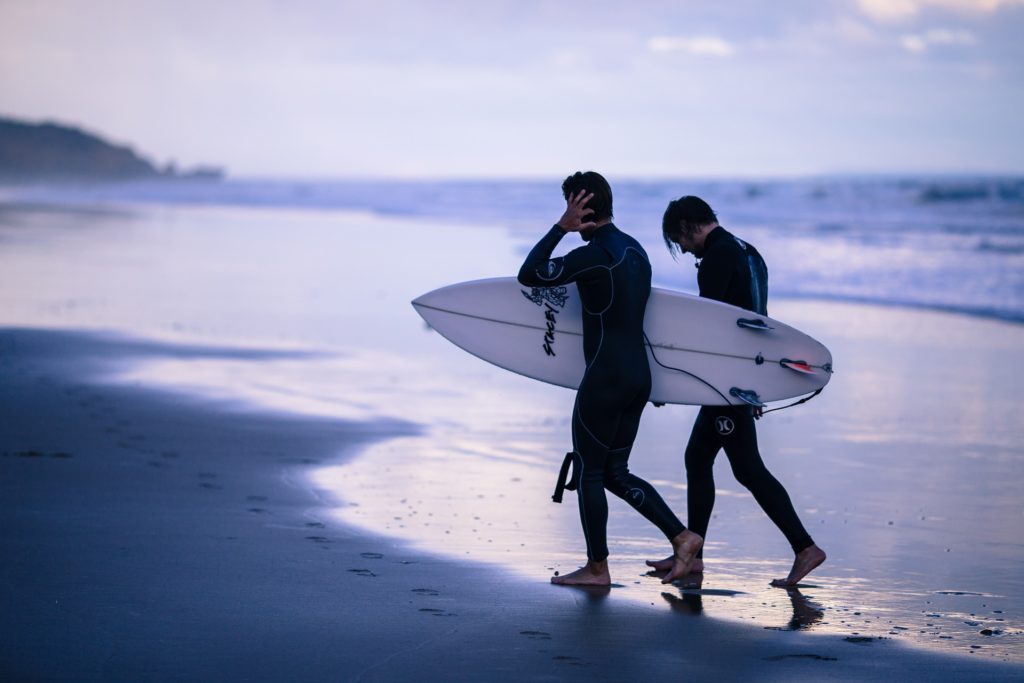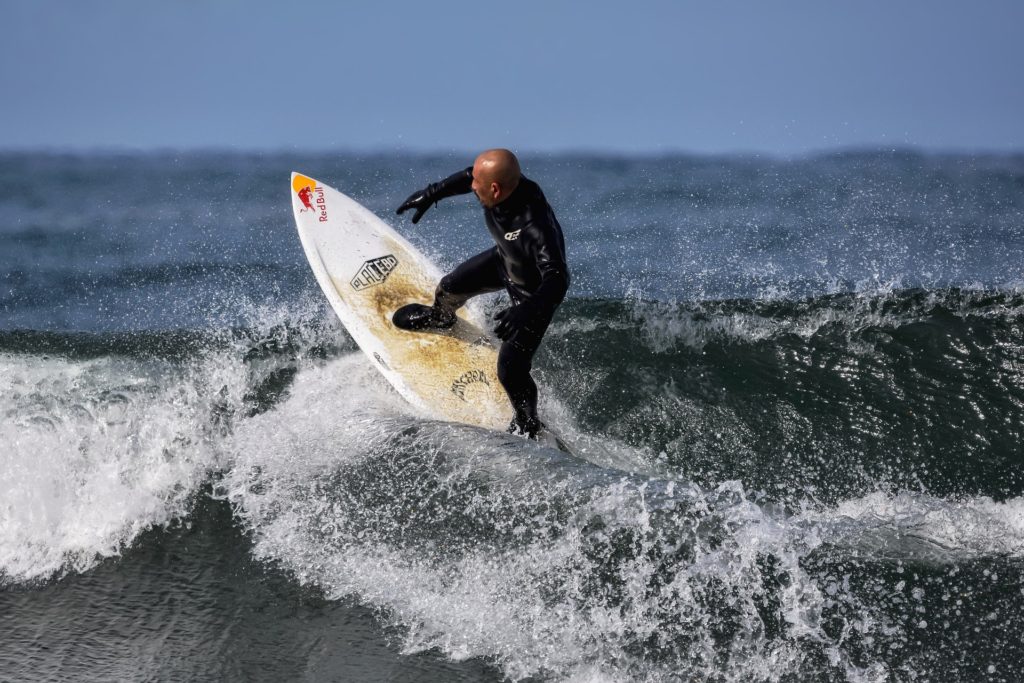Every wave counts! Part of the joy of surfing is in harnessing the momentum of massive bodies of water for sport. Surfing requires the daring and technical skills to overcome one of nature’s most powerful forces.
Why do surfers wear helmets? Surfers wear helmets to protect themselves when undercurrents or waves knock the surfer against their board or the ocean floor. Concussions are one of the most prevalent and dangerous surfing-related injuries.
The force of the tides can be unpredictable for even the most experienced surfer. Protective equipment, including a quality helmet, is a necessity for any surfer who respects the might of the ocean’s raw power.
Types of Surfer Helmets

Surfing helmets come in a range of designs and offer some interesting features. Even the most basic helmets offer a layer of protection from the elements, while the more sophisticated designs offer complete protection from water, wind, sun, and concussive force. Different helmets are appropriate for different situations. Consider which helmet features you will need for the location in which you will be surfing.
Multi-Purpose Helmets
The most basic surfing helmets are designed for all watersports and offer a range of simple features. Multi-purpose helmets are great if you’re an extreme sports devotee like to windsurf, paraglide, skydive, surf, ski, etc.
The benefits of a multi-purpose are that they can be rather cheap and offer good protection for a lot of activities. If you plan to surf a few times a year as you seek other thrills, a multi-purpose helmet may be for you.
You might also like the convenience of being able to lose or destroy and replace a quality multi-purpose helmet. Some multi-purpose helmets will offer the costly features below, but they also come in simple and inexpensive designs.
Convertible Surf Helmets
A convertible surf helmet is any helmet that has ear vents that can be opened when you need to hear your mates and closed to keep water out. Convertible surf helmets are one of the most standard and common designs.
Convertible helmets often prove to be designed for surfing specifically and are usually of more use to habitual or lifelong surfers. These can also be cost-efficient as they come in a number of inexpensive designs.
Sport Surf Helmets
Sport surf helmets come with a number of advanced designs at advanced cost. Sport surf helmets will offer the ear valves of convertible helmets while sporting other features such as an adjustable lining to keep water out and warmth in.
Sport models also offer higher-grade materials that are lighter and offer increased protection. Some also offer advanced comforts, such as padded lining and chin straps. You might invest in a sport helmet if you surf regularly, or if you are traveling to a location to surf where you will want advanced comfort or protection.
Advanced Surf Helmets
Some surf helmets are made from materials that are completely protected from UV and won’t degrade when exposed to harsh sun, making them durable and long-lasting.
Others offer advanced water protection or audio valves, while some modes go so far as to be built with goggles or a face shield. While not standard, each of these designs is useful for protection in certain situations.
Brands
Popular brands of surfing helmets include:
- Gath Sports is dedicated to surfing equipment and produces top-quality products and consistently land on lists for best designs and functions.
- Pro-Tec is a large sporting manufacturer and distributor and offers a few reasonably priced helmet designs.
- Aropec Watersports offers simple, multi-purpose watersports helmets and gear.
- NeilPryde Watersports offers a range of watersports equipment, including simple, lightweight helmets.
- Tontron Sports is focused on sporting producing helmets of high-quality material.
Benefits of Surfer Helmets

Of all of the sports that require a helmet, surfing in one in which helmets are crucial. Still, some surfers think helmets are bulky and uncool, even as professional surfers are regularly injured.
Professional surfer Mercedes Maidana was once a wave-breaking leader for female surfers. As the first woman to surf the famous El Buey in Chile, Maidana seemed a master of intense and rough waves.
That is until the day at Nelscott Reef when a wave got out of Maidana’s control, crashing over her and pulling her under. She was rescued and returned to shore on a jet ski, smiling but visibly injured.
Maidana suffered a concussion and some long-term effects, like delayed speech and movement, from this seemingly innocuous accident. “Nobody talks about concussions in surfing,” says Maidana, even though professional and amateur surfers are being injured often.
A helmet may seem like an unnecessary inconvenience when gearing up to catch some waves, but they could prevent concussions that are life-threatening in the worst cases and cause lifelong harm in the mildest.
The benefits of surfing helmets are numerous, but this list should convince you to don some protective headgear before the next time you paddle out.
Head Protection
Head protection is the primary and most obvious benefit of wearing a surfing helmet. Maidana’s story is just one example of even the most professional and experienced surfers suffering a head injury and trauma from a surfing accident.
There is a culture in surfing that considers helmets uncool and inconvenient, but the best surfing helmets are neither. Wearing a helmet to combat that culture is the coolest thing to do.
Surfing is dangerous for a lot of reasons, and you can find some situations below that especially require helmets, but you should always wear a helmet to avoid currents bashing your head with your board are the limbs and boards of other surfers.
Waterproofing
Waterproofing is one of the express benefits of surfing. Even the most basic surfing helmets will keep water out of your ears, and some can keep your entire head dry. The pressure of rolling waves of water can be massive, and it is important to protect your ears from exposure to that pressure. Some helmets are built with audio valves so that you don’t have to sacrifice convivence.
Sunlight
Sunlight and UV rays are impossible to avoid while surfing. Harmful UV light from the sun filters down onto your skin and scalp even on the cloudiest days. All surf helmets offer protection from the sun, and some go so far as to offer complete UV protection so that the product you buy will be sure to last from exposure to even the harshest rays.
Kids
Children are especially susceptible to head injury. As in adolescent football, there is an increased risk and concern for children and teens when a head injury is a possibility.
It is crucial that adults impress on kids and teens from the time they start surfing that they wear proper protective equipment. At greater risk from the long-term effects of head injury, any concerned parent will see the importance of encouraging minors to wear helmets.
Additionally, removing the social stigma of wearing a helmet for a person at a young age is likely to produce an adult that is a cautious surfer who wears protective gear.
It should be stressed that cautious surfing practices are just as important as protective equipment. Surfers should be aware of all the risks involved with different waves and wave zones.
Helmets can only protect surfers from accidents; a surfer who voluntarily goes into big, dangerous waves is making themselves susceptible to the consequences of that wipeout, even with a helmet.
When You Should Wear Surfer Helmets

While it is smart to wear a helmet at all times while surfing, anytime you are surfing in an area where there is even minor risk of head injury from a rocky ocean floor or coral reef, a helmet is a necessity.
Surfers always check the conditions of the beach and waves before heading into the water or paddling past the impact zone. There is no substitute for proper planning and, when combined with protective gear like a helmet, surfing will be just as exciting while less dangerous and risky.
Crowded Beaches
Crowded beaches increase the danger of any day of surfing and are a prime reason to equip a helmet. Whether there are lots of local beachgoers or there is a long lineup of surfers, helmets will protect everyone around.
When a wave takes you, undercurrents and riptides can carry you down the beach or far ashore of the spot where you began. It would be easy to wash ashore among a rocky outcropping or a group of swimmers, putting yourself and others in danger.
Underwater currents can carry you and your board fast enough to injure you or others that might be surfing or swimming. A helmet can protect from any injuries that can occur should you knock your head against a board.
Beginners
Beginner surfers should always wear helmets. Even the most experienced surfers get into accidents because of the unpredictable and powerful force of the ocean. If you haven’t been surfing for long or have never surfed, a helmet is imperative.
When you first start surfing, it can seem impossible just to balance your weight on the board, to master popping up fast and standing slowly. It can be even harder to socially navigate a busy area.
Understanding where to paddle out, where to ride, and which waves to catch can be difficult for novice surfers. Wearing a helmet ensures that misunderstandings don’t lead to dire consequences.
Novice surfers should talk to other surfers, learn the beach and the waves, and, above all, wear the proper protective gear, including a helmet. As common as it is for professional surfers to be injured, beginning surfers take on even greater risk if uninformed and unprotected.
Some surfing areas have designated areas for beginners. While a helmet is still necessary, surfing in beginner, white water zones can be a safe way to practice your skills before taking on the big waves beyond the impact zone.
Big Waves

Aside from man-made situations, there are multiple natural situations that cause even the most skilled and knowledgeable surfers to wear head protection. The primary one is when there are big, violent waves.
Admittedly, tall, strong waves can be the most enticing to surfers. Catching the biggest waves and breaks or, better still, capturing a photo of the moment, is the ultimate for surfers. Protection and caution, especially in situations with big waves, are invaluable.
Big waves cause undercurrents with more force and pose more risk. Skilled and professional surfers, such as Shawn Dollar, still caution surfers from taking on the biggest waves and say that helmets are a necessity even if they can’t fully protect surfers from the dangers of violent currents.
There are several different wave zones that have varying levels of danger. Check out this article to learn more about these wave zones.
Helmets can provide an added layer of protection for cautious surfers. This is necessary, again, because the ocean can be cruel and unpredictable, and skill is not always the victor when navigating across forces of nature.
Reefs and Shallow Oceans
Just like big waves, surf locations that have shallow reefs can be particularly threatening, presenting a danger from which a helmet provides protection.
Reefs present an increased threat of lacerations or head injury, and if they lay just below the surface, they pose all the more risk. A helmet, combined with other protective gear, can provide useful protection against reef accidents.
The popular site Teahupo’o, over the reefs off the south coast of Tahiti, is known for serious injuries caused by unprepared or unprotected surfers wiping out into the reefs.
Surfing off of the coast of an island in the Pacific offers an exclusive thrill, and a helmet provides a layer of security and protection for that experience.
Riptides
Underwater currents called riptides can threaten surfers no matter the size or strength of the waves on the surface. Riptides can be especially dangerous because they are hard to fight and easy to slip into.
A riptide is an underwater current driven by waves breaking on the coast. A steady tide can cause riptides that run along the coastline for miles, and getting caught in one can be especially dangerous.
A helmet protects surfers if they are pulled into a riptide by keeping water out of the ears and guarding the head against bumps against potentially the rocky or reef-covered ocean floor.
Extreme Weather

Sometimes, the best waves aren’t on warm, sunny days, but on cold, cloudy ones. In addition to protecting from harsh sunlight, as mentioned above, a helmet can be a source of insulation if you want to catch some waves on a chilly day.
Many helmet designs have an insulating layer or create a watertight seal, which will keep heat in. Don’t worry about overheating, though, because most designs also feature ear vents. Whether the weather is icy or hot, a helmet can protect the head and scalp from inclement conditions.
Reading Surf Conditions
The winds, tides, weather, and ocean floor all combine to produce different surfing conditions that might pose an increased risk and require a sturdy helmet.
Winds that flow across the surface of the water, toward the shore, or away from the shore all cause different wave types and shapes to form. The speed and strength of waves also change with the tides over the course of the day.
Are your waves crumbly or prone is the lip prone to fall and break quickly? What about the wave’s height and speed? Spend some time watching the waves before you set out so that you are prepared for your rides.
The big, dramatic, hollow waves that are classic in Hollywood might not make the best waves to ride, depending on surf conditions. Proper protective gear is crucial, but being familiar with surf conditions and reading the waves is equally necessary.
Helmet Culture
Helmets may not be the most cool-looking or convenient pieces of equipment, but from pros to novices, the importance of wearing a helmet is clear. The culture that discourages surfers, and especially young surfers, from wearing helmets needs to be redirected.
Rather, surfers should normalize wearing helmets. Not to support the surfing gear and helmet makers, but to encourage a culture of protection and safety. Helmets are just one piece of that.
Surfing is a thrilling hobby that requires dedication to learn, and no shortage of raw skill and talent to master, but even masters make mistakes. Head injuries are dangerous and common among professional surfers, and the risk is increased for amateurs.
Catching that next wave, or the biggest wave could also mean a life-threatening accident or one that could have lifelong health impacts. Surfers who suffer concussions underwater are more likely to drown.
If one survives an underwater impact, a concussion could also damage motor function, speech, and cause irreparable brain or nerve damage. The lack of a helmet and a routine accident could end your ability to chase the thrill of surfing.
Be part of the movement to ensure that safety and protection are a priority in surfing at all levels so that fewer people are put at risk in the name of social stigma or inconvenience.






